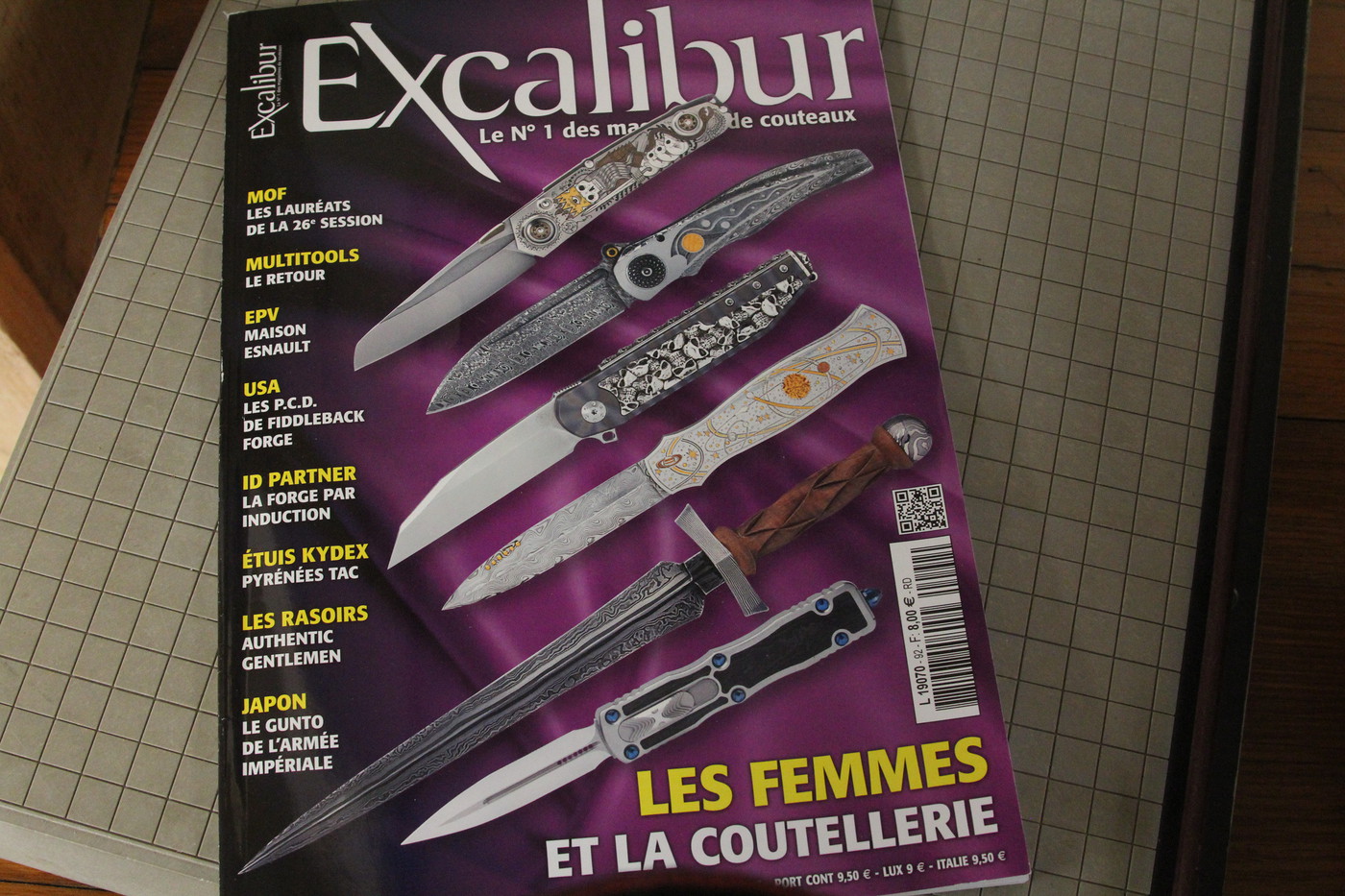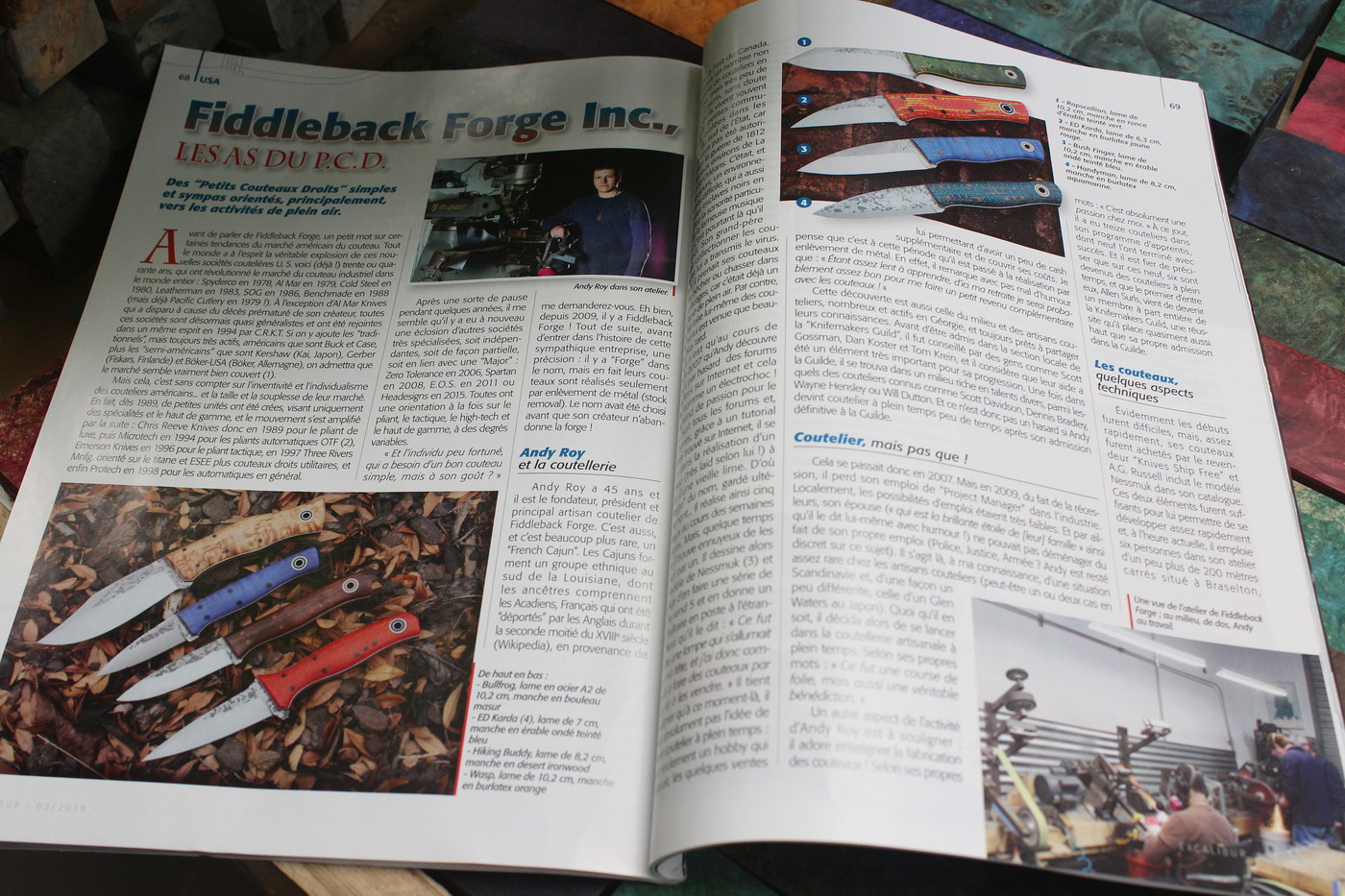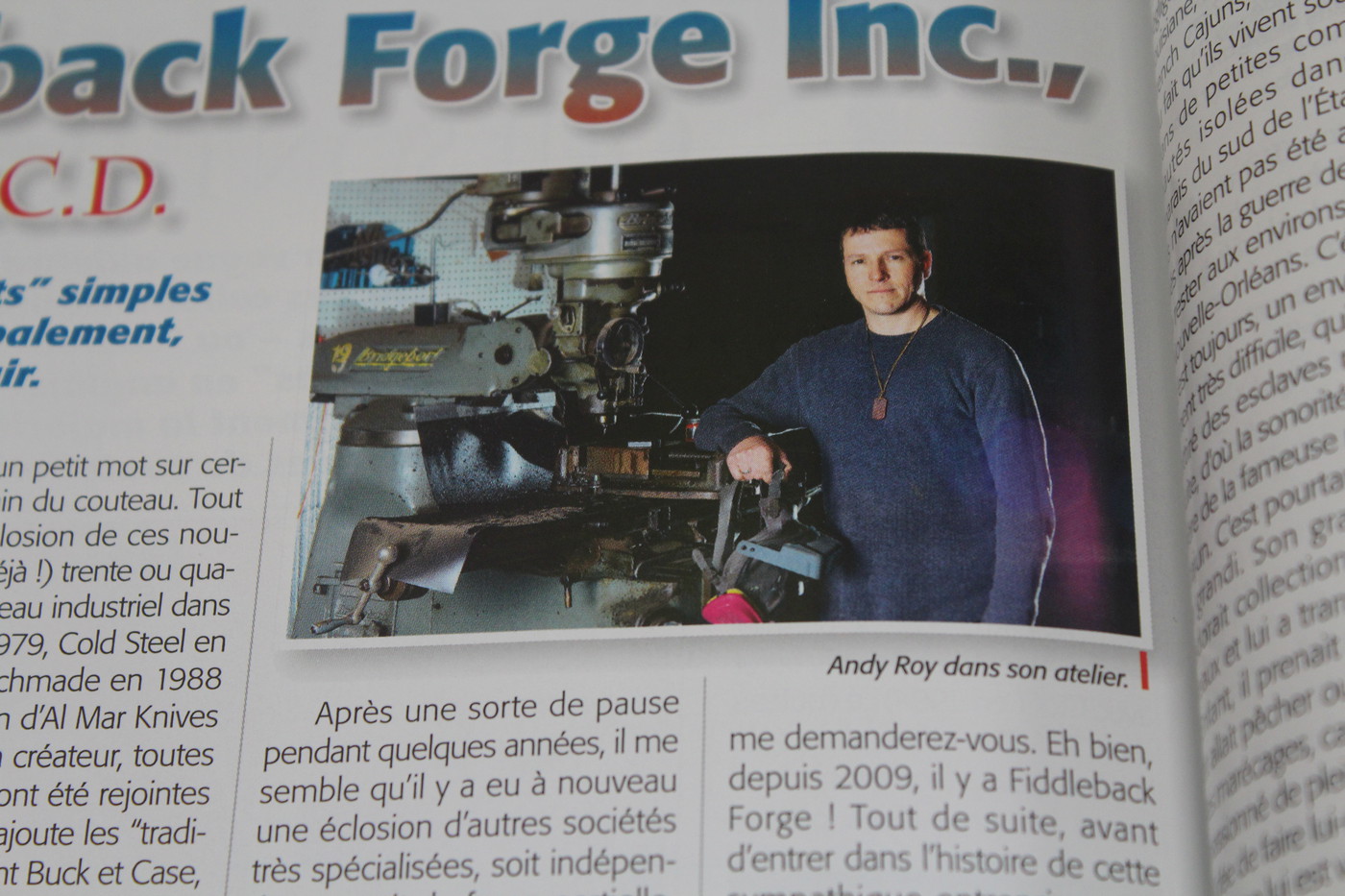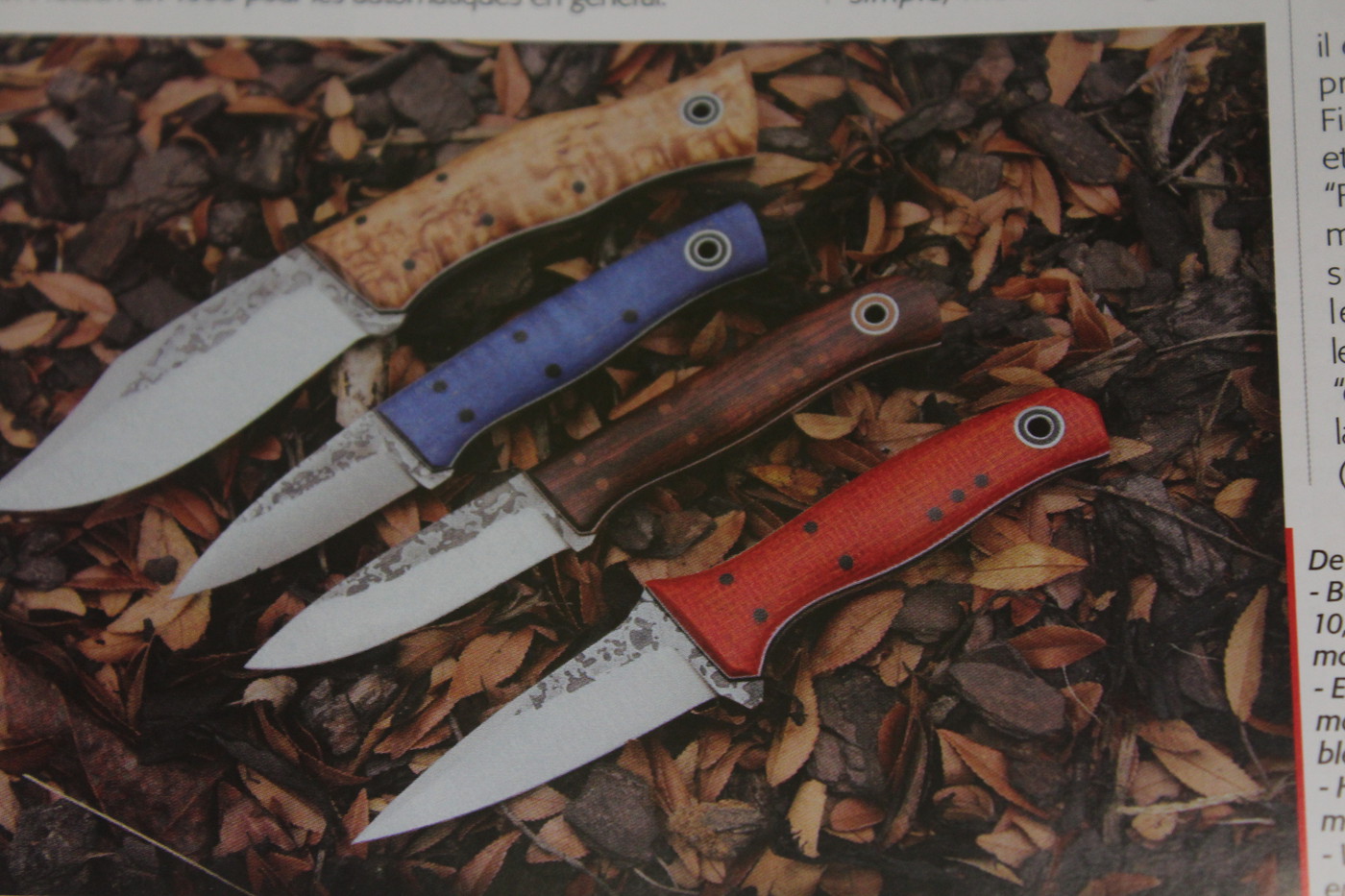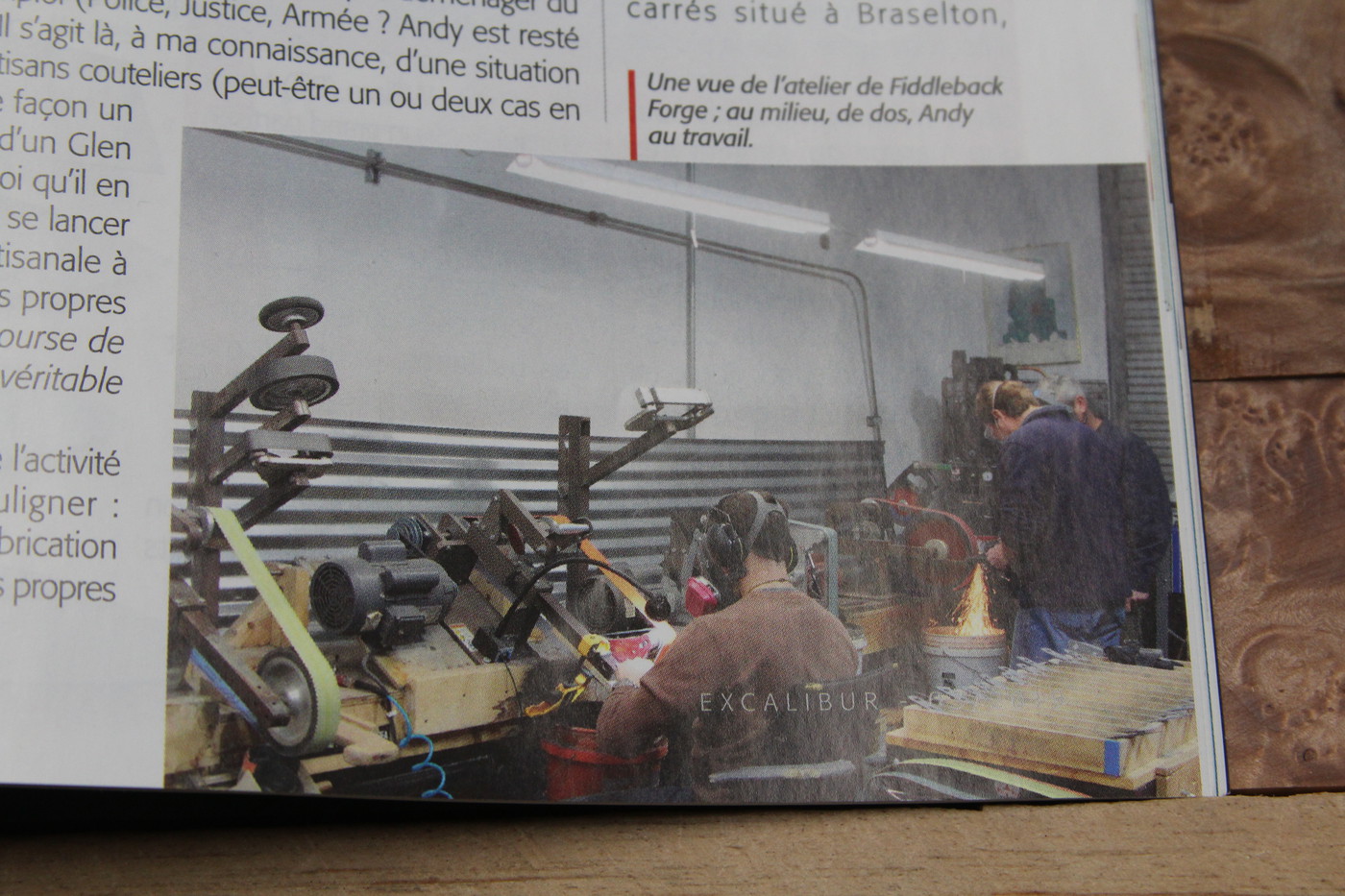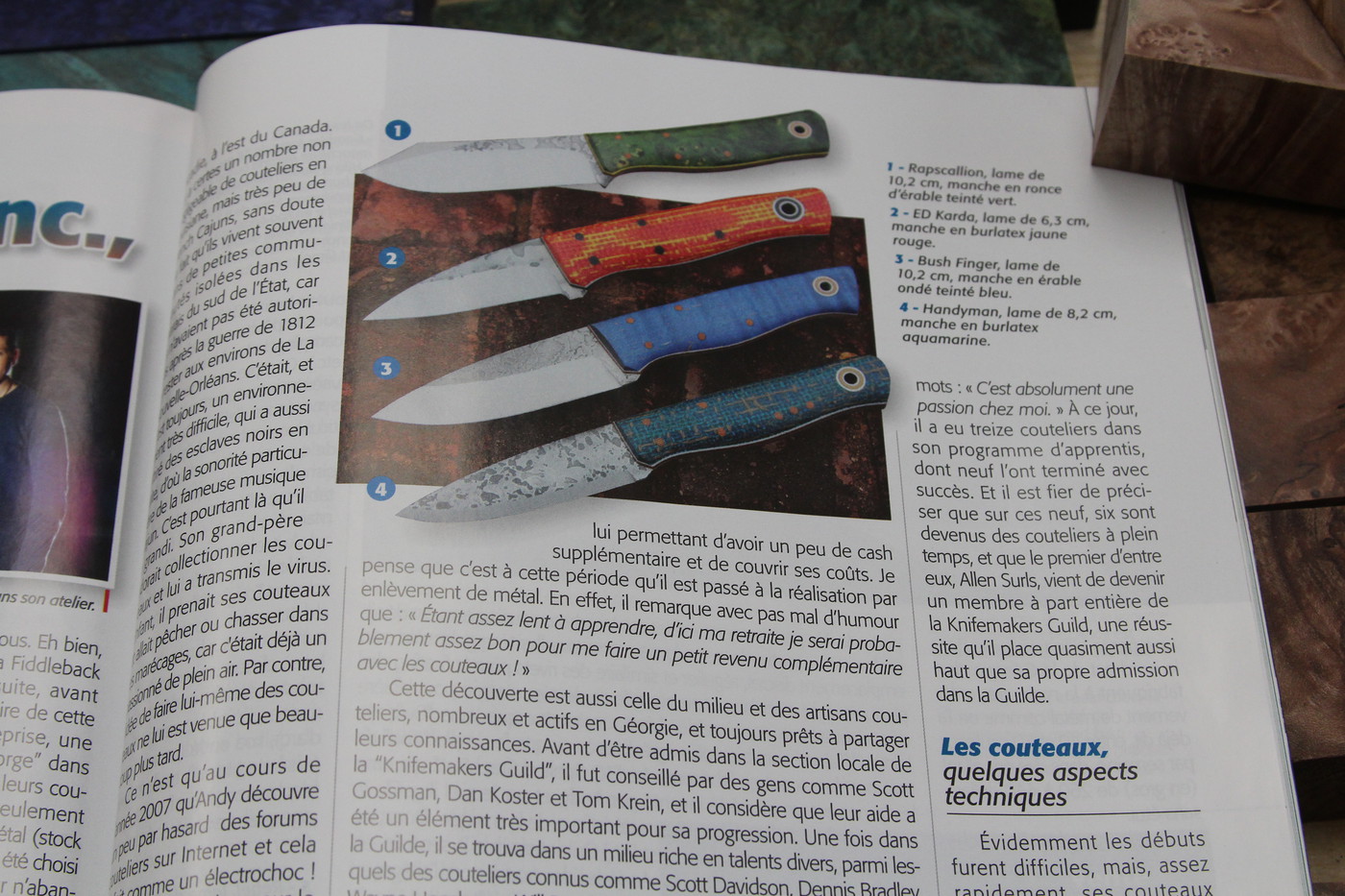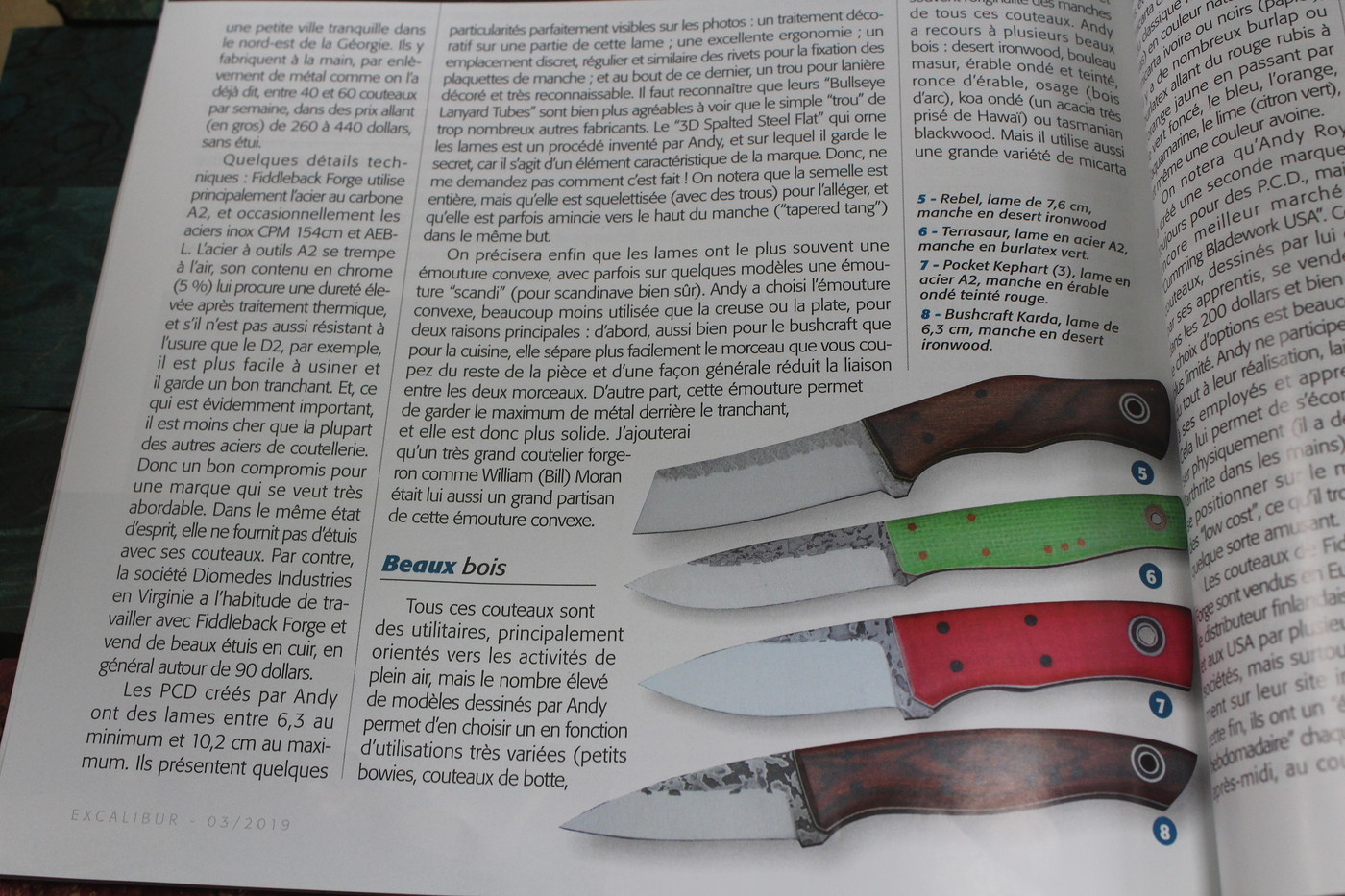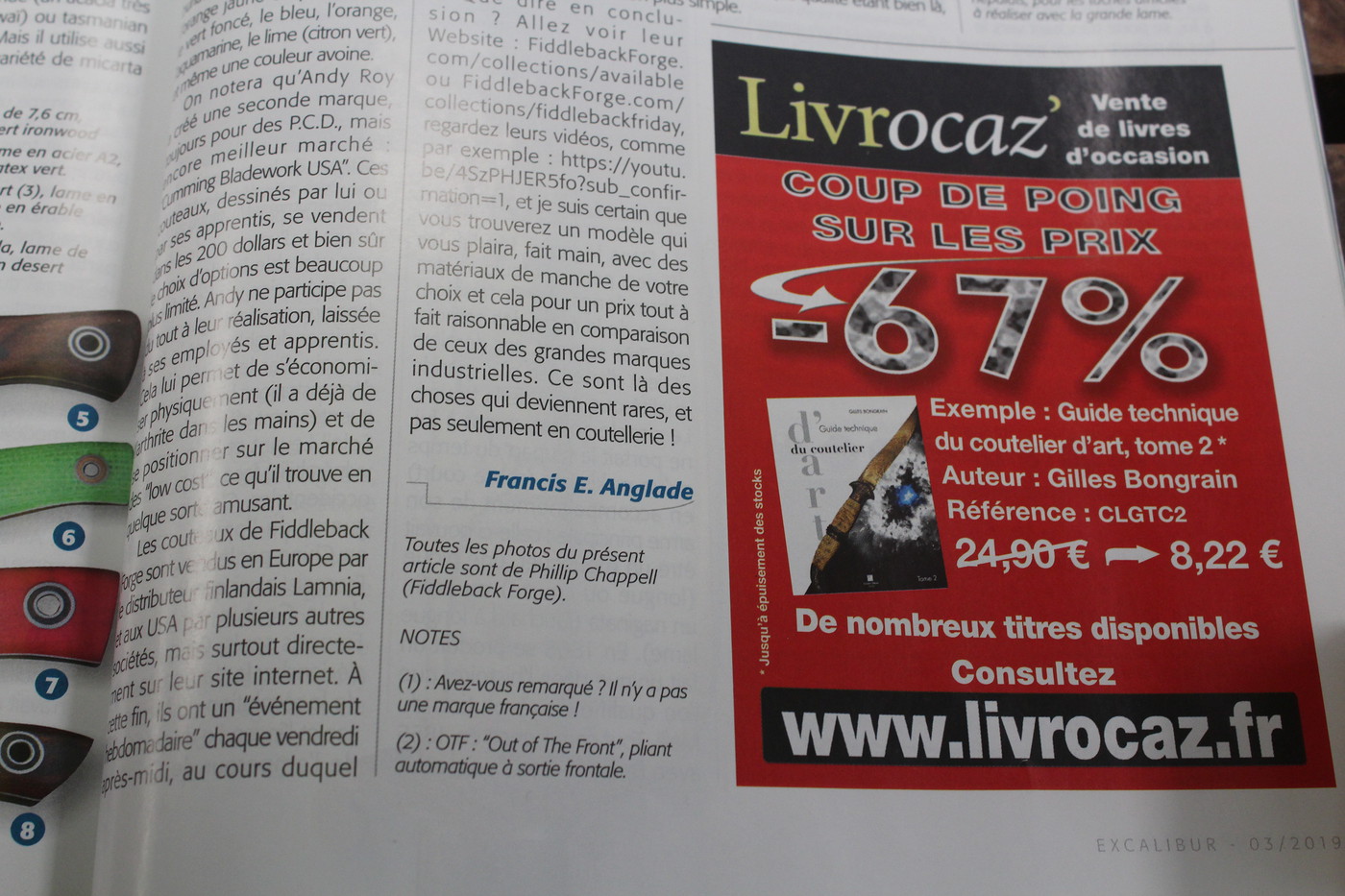You are using an out of date browser. It may not display this or other websites correctly.
You should upgrade or use an alternative browser.
You should upgrade or use an alternative browser.
Parlez-Vous Francais?
- Thread starter VANCE
- Start date
Warrior108
Platinum Member
- Joined
- Apr 24, 2012
- Messages
- 3,803
Nice!!
- Joined
- Jul 15, 2003
- Messages
- 358
that's really cool! congrats guys!
- Joined
- Mar 13, 2006
- Messages
- 13,878
This is the only one im aware ofthey did reference the French Cajun heritage in Andy's bio. had to call out the French part. so... how many other international pubs for Fiddlebacks?
- Joined
- Mar 13, 2006
- Messages
- 13,878
we had a generous forum member translate the article for us. here are his findings......
"
TITLE]
THE ACES OF P.C.D. [“Small Straight Knives”]
Simple and nice "Small Straight Knives" oriented
mainly towards outdoor activities.
[Philip — This following paragraphs I translated from two photos in your first email to me:]
Before talking about Fiddleback Forge, a few words about certain trends in the American knife market. In the last 30 to 40 years there’s been a veritable explosion of new companies, which has revolutionized the knife making industry: Spyderco in 1978, Al Mar in 1979, Cold Steel in 1980, Leatherman in 1983, Benchmade in 1988 (but already Pacific Cutlery in 1979!). With the exception of Al Mar Knives, which disappeared because of the premature death of its creator, all these companies are generalists and have continued in the same spirit, joined in 1994 by CRKT. If one adds the “traditionalist” and very active American firms like Buck and Case, plus semi-Americans such as Kershaw (Kai, Japan), Gerber (Fiskars, Finland) and Boker-USA (Boker, Germany), one might assume that the market was truly well covered.
But that wouldn’t count the inventiveness of individual American knifemakers, and the size and variety of their market. In fact, since 1989, small makers together have created a range of high-end specialties, with the movement boosted by the following: Chris Reeves Knives in 1989 for deluxe folders, then Microtech in 1994 for automatic OTF folders, and Emerson Knives in 1996 for automatiques [“automatics” , mechanicals?] in general.
After a pause of a few years, there was a new explosion of very specialized companies, either wholly or partially independent, or in partnership with a “Major”: Zero Tolerance in 2006, Spartan in 2008, E.O.S. in 2011, or Headesigns in 2015. All were oriented toward folders, tactical, high-tech and high end to varying degree.
And for a few fortunate individuals looking for a beautiful, simple knife to suit his taste, I ask you? Well, since 2009 they have Fiddleback Forge! First, before going into the history of this appealing enterprise, a clarification: ‘Forge’ is in the name, but they make their knives only by removing stock. The name has been chosen because the creator has not abandonned the forge!
[Photograph — caption under the photo of Andy with his right arm resting on the machine:] “Andy Roy in his workshop”
[Sidebar ]— Andy Roy and the cutlery works [la coutellerie]
Andy Roy is 45 years old and the founder, president and principal knifemaker at Fiddleback Forge. He is also, and this is very rare, a “French Cajun”. Cajuns are an ethnic group in south Louisiana, whose ancestors were Acadians, French who were deported by the English during the second half of the 18th century, (Wikipedia), [Phillip — This is the end of what I translated from the photos in your first email to me. Those photos don’t show anything I can see finishing this sidebar, and end with the French words “en providence de …”. It looks to me as though I didn’t receive your 2nd email.]
[Next section is from the photos attached to email “pt3” you sent to me. The translation begins in the middle of a sentence:]
“… knife (very ugly according to him!) from an old file. As for where the name “Forge" part of name come from …, he doesn’t explain until later. Over the following several weeks he made five knives. Sometime after that he found it boring to make them one by one. He then drew a model of the Nessmuk and he decided to make a series of six of them. He sold five and sent one to a soldier posted abroad. In his words: "It was like a lamp that lit up in my head, so I started making knives by series and selling them." He would like to stress that at that time, he had absolutely no idea of becoming a full-time knifemaker: It was only a hobby that provided a little extra cash to cover his expenses. I think it was during this period that he settled on making making knives by removing metal. Indeed, he remarks with a lot of humor that: "Being slow enough to learn, by the time I retire I will probably be good enough to make a little extra income with knives!" [Phillip — This sounds as if it was something Andy was telling the writer that he had thought to himself back at the time.]
He also discovered the community of many active knifemakers in Georgia, always ready to share their knowledge. Before being admitted to the local Knifemakers Guild, he was advised by people like Scott Grossman, Dan Koster and Tom Krein, and found the Guild to be an environment rich in various talents, including knifemakers Scott Davidson, Dennis Bradley, Wayne Hensley and Will Dutton. It is therefore no coincidence that Andy became a full-time knifemaker shortly after his admission into the Guild.
[End of what I could decipher in your email #3.]
[On to translating from your email #4:]
This all happened in 2007. But in 2009, due to recession, he lost his job as an industrial "Project Manager.” Local job opportunities were very scarce. And besides, his wife (who is the bright star of their family as he himself says with humor!) could not move because of her own job. (Was it for the Police, Justice, Army? Andy stayed discreet on this subject.) This is, to my knowledge, a fairly rare situation among knifemakers (perhaps one or two cases in Scandinavia and, in a slightly different way, that of a Glen Waters in Japan). Anyway, he decided to go into knifemaking [literally ‘craft cutlery’] full time. In his own words: "It was a crazy time, but also a real blessing."
But regarding his new work, he also said, "It is absolutely a passion for me." To date, he has had thirteen apprentice knifemakers in his apprenticeship program, nine of whom have successfully completed it. And he is proud to point out that of these nine, six have become full-time knifemakers, and that the first of them, Allen Surls, has just become a full member of the Knifemakers Guild, a success practically as high as his own admission to the Guild.
"
TITLE]
THE ACES OF P.C.D. [“Small Straight Knives”]
Simple and nice "Small Straight Knives" oriented
mainly towards outdoor activities.
[Philip — This following paragraphs I translated from two photos in your first email to me:]
Before talking about Fiddleback Forge, a few words about certain trends in the American knife market. In the last 30 to 40 years there’s been a veritable explosion of new companies, which has revolutionized the knife making industry: Spyderco in 1978, Al Mar in 1979, Cold Steel in 1980, Leatherman in 1983, Benchmade in 1988 (but already Pacific Cutlery in 1979!). With the exception of Al Mar Knives, which disappeared because of the premature death of its creator, all these companies are generalists and have continued in the same spirit, joined in 1994 by CRKT. If one adds the “traditionalist” and very active American firms like Buck and Case, plus semi-Americans such as Kershaw (Kai, Japan), Gerber (Fiskars, Finland) and Boker-USA (Boker, Germany), one might assume that the market was truly well covered.
But that wouldn’t count the inventiveness of individual American knifemakers, and the size and variety of their market. In fact, since 1989, small makers together have created a range of high-end specialties, with the movement boosted by the following: Chris Reeves Knives in 1989 for deluxe folders, then Microtech in 1994 for automatic OTF folders, and Emerson Knives in 1996 for automatiques [“automatics” , mechanicals?] in general.
After a pause of a few years, there was a new explosion of very specialized companies, either wholly or partially independent, or in partnership with a “Major”: Zero Tolerance in 2006, Spartan in 2008, E.O.S. in 2011, or Headesigns in 2015. All were oriented toward folders, tactical, high-tech and high end to varying degree.
And for a few fortunate individuals looking for a beautiful, simple knife to suit his taste, I ask you? Well, since 2009 they have Fiddleback Forge! First, before going into the history of this appealing enterprise, a clarification: ‘Forge’ is in the name, but they make their knives only by removing stock. The name has been chosen because the creator has not abandonned the forge!
[Photograph — caption under the photo of Andy with his right arm resting on the machine:] “Andy Roy in his workshop”
[Sidebar ]— Andy Roy and the cutlery works [la coutellerie]
Andy Roy is 45 years old and the founder, president and principal knifemaker at Fiddleback Forge. He is also, and this is very rare, a “French Cajun”. Cajuns are an ethnic group in south Louisiana, whose ancestors were Acadians, French who were deported by the English during the second half of the 18th century, (Wikipedia), [Phillip — This is the end of what I translated from the photos in your first email to me. Those photos don’t show anything I can see finishing this sidebar, and end with the French words “en providence de …”. It looks to me as though I didn’t receive your 2nd email.]
[Next section is from the photos attached to email “pt3” you sent to me. The translation begins in the middle of a sentence:]
“… knife (very ugly according to him!) from an old file. As for where the name “Forge" part of name come from …, he doesn’t explain until later. Over the following several weeks he made five knives. Sometime after that he found it boring to make them one by one. He then drew a model of the Nessmuk and he decided to make a series of six of them. He sold five and sent one to a soldier posted abroad. In his words: "It was like a lamp that lit up in my head, so I started making knives by series and selling them." He would like to stress that at that time, he had absolutely no idea of becoming a full-time knifemaker: It was only a hobby that provided a little extra cash to cover his expenses. I think it was during this period that he settled on making making knives by removing metal. Indeed, he remarks with a lot of humor that: "Being slow enough to learn, by the time I retire I will probably be good enough to make a little extra income with knives!" [Phillip — This sounds as if it was something Andy was telling the writer that he had thought to himself back at the time.]
He also discovered the community of many active knifemakers in Georgia, always ready to share their knowledge. Before being admitted to the local Knifemakers Guild, he was advised by people like Scott Grossman, Dan Koster and Tom Krein, and found the Guild to be an environment rich in various talents, including knifemakers Scott Davidson, Dennis Bradley, Wayne Hensley and Will Dutton. It is therefore no coincidence that Andy became a full-time knifemaker shortly after his admission into the Guild.
[End of what I could decipher in your email #3.]
[On to translating from your email #4:]
This all happened in 2007. But in 2009, due to recession, he lost his job as an industrial "Project Manager.” Local job opportunities were very scarce. And besides, his wife (who is the bright star of their family as he himself says with humor!) could not move because of her own job. (Was it for the Police, Justice, Army? Andy stayed discreet on this subject.) This is, to my knowledge, a fairly rare situation among knifemakers (perhaps one or two cases in Scandinavia and, in a slightly different way, that of a Glen Waters in Japan). Anyway, he decided to go into knifemaking [literally ‘craft cutlery’] full time. In his own words: "It was a crazy time, but also a real blessing."
But regarding his new work, he also said, "It is absolutely a passion for me." To date, he has had thirteen apprentice knifemakers in his apprenticeship program, nine of whom have successfully completed it. And he is proud to point out that of these nine, six have become full-time knifemakers, and that the first of them, Allen Surls, has just become a full member of the Knifemakers Guild, a success practically as high as his own admission to the Guild.
- Joined
- Mar 13, 2006
- Messages
- 13,878
[End of “pt4” email]
[Beginning of “pt5” email]
The knives — some technical aspects
Obviously the beginnings were difficult, but, fairly quickly, his knives were bought by the retailer Knives Ship Free, and AG Russell included the Nessmuk model in its catalog. These two steps were sufficient to allow him to develop fairly quickly and, at present, he employs six people in his workshop of just over 200 square meters located in Braselton, ….
[End of “pt5”email]
[Beginning of “pt6” email]
[I couldn’t find the beginning of this sentence, but it was probably something like: The Forge is located in —blank —]
… a small, peaceful villiage in northeast Georgia. They make the knives there by hand, by removing metal as we have already said, producing between 40 and 60 knives per week, at prices ranging from 260 to 440 dollars, without a sheath.
Some technical details: Fiddleback Forge uses primarily A2 carbon steel, and occasionally the steels CPM 154 and AEB-L. Tool steel is air quenched, its chromium content (5%) gives it high hardness after heat treatment, and if it is not as resistant to wear as D2, for example, it is easy to machine and it keeps a good cutting edge. And, what is obviously important, it is cheaper than most other cutlery steels. So a good compromise for a brand that wants to be very affordable. Consistent with this approach, [literally “In the same state of mind”] the Forge does not provide sheaths with its knives. On the other hand, the company Diomedes Industries in Virginia, used to work with Fiddleback Forge and sells beautiful leather sheaths, in general for around 90 dollars.
The PCDs created by Andy have blades between 6.3 minimum and 10.2 cm maximum. Some
[End of “pt6” email and beginning of “pt7”]
details are perfectly visible in the photos: a decorative treatment on each blade; excellent eronomics; simple and regular placement of rivets to attach the scales; and near the end, a hole decorated and very distinctive. It is known as their “Bullseye Lanyard Hole,” visually more pleasing than the simple hole of a number of other manufacturers. The “3D Spalted Steel Flat” that decorates the blade is a process invented by Andy, the secret for which he guards, as it is an element characteristic of the brand. So, don’t ask me to inquire how it is done! One also notices that the tang is full, but sketetonized to lighten it, and sometimes it is thinned toward the end (“tapered tang”) for the same reason.
Finally, it should be noted that the blades often have a convex grind, with a ‘Scandi’ grind on some models (for Scandanavian, of course). Andy chooses a convex grind, [which in the trade is generally (my added words)] much less used than hollow or flat, for two principle reasons: first, in bushcrafting as well as cooking, it separates the piece being cut from the whole much more easily and in a way that reduces the friction between the two pieces. Second, this grind also leaves maximum metal behind the edge, and therefore is more solid. I will add that a very great knifemaker, William (Bill) Moran, was also a supporter of this convex grind.
Beautiful woods
All the knives are useful and mainly oriented towards outdoor activities, but the high number of models designed by Andy allows you to choose on according to a variety of uses (small bowies, boot knives, letter openers, various forms for fishing or hunting, camping, bushcraft, survival, etc.). Given that these fairly uses are often for sport and effort-intensive activities, Andy has given particular attention to the ergonomics of his handles, which appear simple but are always comfortable whatever the grip.
[End of “pt7” and beginning of email 8, called “No Subject”]
Other visible characteristics: the quality, the variety and often originality evident in all these knives. Andy has recourse to many beautiful woods: desert ironwood, masur birch, maple wavy and dyed, maple burl, osage, koa (an acacia very prized in Hawaii), or Tasmanian blackwood. But he also utilizes a great variety of micarta and some G10, often very colorful, permitting a large range of personalization in his models.
Micarta is a composite material with a base of paper or cotton or linen combined with a phenolique resin (Wikipedia). Burlap or burlatex micarta is a variety with a base of jute commonly used in the last years since it offers colors and characteristics different from classic micarta. Thus, in addition to the classic natural canvas micarta, ivory micarta, and black micarta, there are a number of burlap or burlatex in ruby red, orange-yellow, deep green, orange, aquamarine, lime, … [couldn’t find rest of this sentence]
[End of 8th email and beginning of 9th email, called “last one.”]
Fiddleback Forge knives are sold in Europe by Finnish distributor Lamnia, and in the USA by many other retailers, but only directly by the Forge on its internet site. To do this they have a weekly event each Friday afternoon at which the week’s production is first shown at 15 o’clock (USA), and in the evening it is offered to the first buyers [literally] financially confirming their choice. This is an original system and always sells well. Note that Fiddleback Forge also produces videos of about fifteen minutes, available on the Internet, giving a more precise idea than a simple photo of their models and their handling.
Each week one can also buy two knives made by apprentices, generally for about 200 dollars; it is an interesting option, the quality being good, but in a simpler presentation.
What to say in conclusion? Go see their website: FiddlebackForge.com/collections/available or FiddlebackForge.com/fiddlebackfriday, to see their videos, for example: http://youtube/4SzPHJER5fo?sub_confirmation=1, and I am certain that you will find a model that will please you, handmade, of material suiting your choice and for a price reasonable in comparison to the well-known industrial brands. These are objects that become rare, and not just knives!
[Beginning of “pt5” email]
The knives — some technical aspects
Obviously the beginnings were difficult, but, fairly quickly, his knives were bought by the retailer Knives Ship Free, and AG Russell included the Nessmuk model in its catalog. These two steps were sufficient to allow him to develop fairly quickly and, at present, he employs six people in his workshop of just over 200 square meters located in Braselton, ….
[End of “pt5”email]
[Beginning of “pt6” email]
[I couldn’t find the beginning of this sentence, but it was probably something like: The Forge is located in —blank —]
… a small, peaceful villiage in northeast Georgia. They make the knives there by hand, by removing metal as we have already said, producing between 40 and 60 knives per week, at prices ranging from 260 to 440 dollars, without a sheath.
Some technical details: Fiddleback Forge uses primarily A2 carbon steel, and occasionally the steels CPM 154 and AEB-L. Tool steel is air quenched, its chromium content (5%) gives it high hardness after heat treatment, and if it is not as resistant to wear as D2, for example, it is easy to machine and it keeps a good cutting edge. And, what is obviously important, it is cheaper than most other cutlery steels. So a good compromise for a brand that wants to be very affordable. Consistent with this approach, [literally “In the same state of mind”] the Forge does not provide sheaths with its knives. On the other hand, the company Diomedes Industries in Virginia, used to work with Fiddleback Forge and sells beautiful leather sheaths, in general for around 90 dollars.
The PCDs created by Andy have blades between 6.3 minimum and 10.2 cm maximum. Some
[End of “pt6” email and beginning of “pt7”]
details are perfectly visible in the photos: a decorative treatment on each blade; excellent eronomics; simple and regular placement of rivets to attach the scales; and near the end, a hole decorated and very distinctive. It is known as their “Bullseye Lanyard Hole,” visually more pleasing than the simple hole of a number of other manufacturers. The “3D Spalted Steel Flat” that decorates the blade is a process invented by Andy, the secret for which he guards, as it is an element characteristic of the brand. So, don’t ask me to inquire how it is done! One also notices that the tang is full, but sketetonized to lighten it, and sometimes it is thinned toward the end (“tapered tang”) for the same reason.
Finally, it should be noted that the blades often have a convex grind, with a ‘Scandi’ grind on some models (for Scandanavian, of course). Andy chooses a convex grind, [which in the trade is generally (my added words)] much less used than hollow or flat, for two principle reasons: first, in bushcrafting as well as cooking, it separates the piece being cut from the whole much more easily and in a way that reduces the friction between the two pieces. Second, this grind also leaves maximum metal behind the edge, and therefore is more solid. I will add that a very great knifemaker, William (Bill) Moran, was also a supporter of this convex grind.
Beautiful woods
All the knives are useful and mainly oriented towards outdoor activities, but the high number of models designed by Andy allows you to choose on according to a variety of uses (small bowies, boot knives, letter openers, various forms for fishing or hunting, camping, bushcraft, survival, etc.). Given that these fairly uses are often for sport and effort-intensive activities, Andy has given particular attention to the ergonomics of his handles, which appear simple but are always comfortable whatever the grip.
[End of “pt7” and beginning of email 8, called “No Subject”]
Other visible characteristics: the quality, the variety and often originality evident in all these knives. Andy has recourse to many beautiful woods: desert ironwood, masur birch, maple wavy and dyed, maple burl, osage, koa (an acacia very prized in Hawaii), or Tasmanian blackwood. But he also utilizes a great variety of micarta and some G10, often very colorful, permitting a large range of personalization in his models.
Micarta is a composite material with a base of paper or cotton or linen combined with a phenolique resin (Wikipedia). Burlap or burlatex micarta is a variety with a base of jute commonly used in the last years since it offers colors and characteristics different from classic micarta. Thus, in addition to the classic natural canvas micarta, ivory micarta, and black micarta, there are a number of burlap or burlatex in ruby red, orange-yellow, deep green, orange, aquamarine, lime, … [couldn’t find rest of this sentence]
[End of 8th email and beginning of 9th email, called “last one.”]
Fiddleback Forge knives are sold in Europe by Finnish distributor Lamnia, and in the USA by many other retailers, but only directly by the Forge on its internet site. To do this they have a weekly event each Friday afternoon at which the week’s production is first shown at 15 o’clock (USA), and in the evening it is offered to the first buyers [literally] financially confirming their choice. This is an original system and always sells well. Note that Fiddleback Forge also produces videos of about fifteen minutes, available on the Internet, giving a more precise idea than a simple photo of their models and their handling.
Each week one can also buy two knives made by apprentices, generally for about 200 dollars; it is an interesting option, the quality being good, but in a simpler presentation.
What to say in conclusion? Go see their website: FiddlebackForge.com/collections/available or FiddlebackForge.com/fiddlebackfriday, to see their videos, for example: http://youtube/4SzPHJER5fo?sub_confirmation=1, and I am certain that you will find a model that will please you, handmade, of material suiting your choice and for a price reasonable in comparison to the well-known industrial brands. These are objects that become rare, and not just knives!
- Joined
- Apr 29, 2016
- Messages
- 786
OK, I'm going to nerd out here. There is actually an app on iOS that you can point the camera to foreign text and it will replace it on your screen with English translation in real time.
https://apps.apple.com/us/app/itranslate-translator/id288113403
https://apps.apple.com/us/app/itranslate-translator/id288113403
- Joined
- Nov 8, 2019
- Messages
- 299

